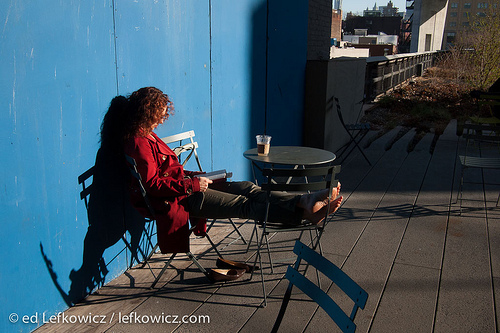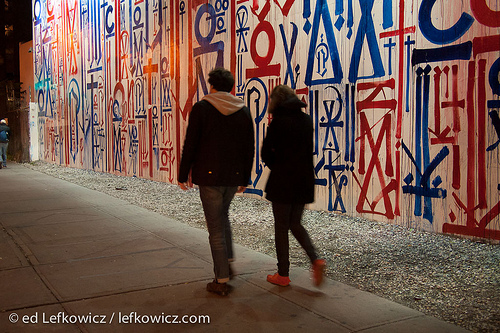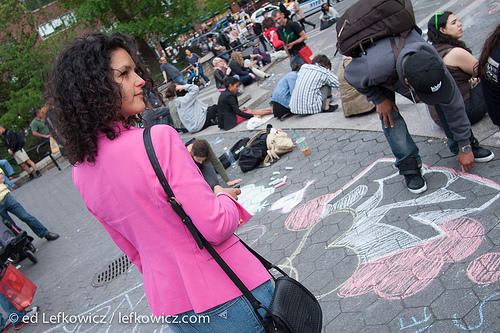
I have always done a lot of street photography, starting in my late teens and continuing on to the present. My earliest photographic hero was (of course) Henri Cartier-Bresson, and he remains one of my photo heroes. I’ve shot in the streets with a Contax rangefinder, a Nikon F, Leica M-4 and M-6, a Mamiya 6, an Olympus Infinity p&s, Canon DSLRs, probably a couple of cameras I’ve forgotten, and, most recently an Olympus E-P2. (OK, I use the camera in my iPhone a lot lately, too, but I’ll deal with that in another post. If you’re dying to see what I do with it, check my Instagram feed: my username is edlefkowicz_.) Some cameras are better suited for the purpose than others—Leicas are pretty much built for the purpose: fast focusing, fast shutter response, small, quiet, unobtrusive. Further down the list are DSLRs (big, heavy, noisy) and compact digital cameras (slow focus, slow shutter response, slow everything). The Olympus E-P2 is not built for the purpose, but there are ways I work around the limitations. And it does have some advantages. I’ll deal with one issue at a time.

Focus. If you depend on autofocus for street photography, you’re screwed: it just takes too long. As soon as your camera has to hunt for focus, you could lose the shot. The first thing to do is to separate the focusing function from the shutter release. With a lot of cameras, including the Olympus, you can change the default setting so you can focus with your thumb on the “AEL/AFL” button. The next thing to do is to pre-focus, and then forget about focusing altogether. “What!” you say? “Don’t focus?” Hell, I prefocused when I was using Leicas. You can get a shot or two off, then refocus if you have to, but if something’s going on that you want to catch, you at least have a chance at it. With a micro 4/3 sensor, even at f/4.0, if you pre-focus at 10 feet, everything from 7 feet to 18 feet will be in focus. Stop down to 5.6, and you’re looking at 6.1 to nearly 28 feet. Find out what the sweet spots are for the photos you like to take and plan ahead. (The Depth of Field Calculator iPhone app is a useful tool to help you plan. There are other, similar apps.)
Exposure. You’re going to hate this one: set the exposure to Manual. Yes, manual, the setting nobody uses. I like to work in places where things are going on: people are interacting, maybe just hanging out. So I’ll hang out for a while to see what happens. Once I see the location, I know what I want the lighting to look like. As long as the sun doesn’t go behind the clouds, I’ll probably want to expose for the highlights, not for the “average” scene. So I set the exposure accordingly. This has two advantages: The camera doesn’t have to do any heavy lifting, computationally; and my exposures will be uniform shot to shot even if I reframe from shot to shot. So will my color balance. You can even do some guess work on this, too. (If you’re old enough, you may recall the “Sunny 16” rule. It still works.)

Being noticed: Most people are uncomfortable with cameras in their faces. I speak from experience, because as a people photographer I put cameras in front of faces for a living. Stick a Canon 5D with a 24-70mm f/2.8 lens with a lens hood in front of somebody, and they will take notice. And may not be happy. And the longer you have a camera in that position, the unhappier they are likely to become. “But wait!”, you say, “you’re talking about a little Olympus! and it doesn’t even have an eye-level viewfinder!” How wise you are, Grasshopper. When people like Cartier-Bresson and André Kertesz were first active, Leicas were so much smaller than the cameras commonly in use they didn’t convey the same message as the earlier, larger cameras. And guess what? Small cameras like the Oly and the Fuji and the new crop of Nikons and Sonys (well, I’m not so sure about some of them: the lenses can be pretty large) don’t look nearly as intimidating to most people as DSLRs. And if you look like a tourist who hasn’t quite figured out his camera, so much the better. (I am not advocating that you go about dressed in a stupid t-shirt, ill-fitting shorts and running shoes with high white tube socks. Just saying.)
While I’m on the subject (Which was what? tourists? being noticed? Yes, both.) I don’t use a shoulder strap for the E-P2. I found a hand strap on eBay that I much prefer. (Just look on eBay for “camera hand strap”.) It attaches to the right strap lug, and then to a plate on the bottom of the camera. My hand slips in, and keeps a good grip. And it’s always ready.
So try it. Take one step at a time, first focus, then exposure. See what happens.
More street photography on my fllickr feed.
And new additions, photos of Greenwich Village and SoHo, here.
